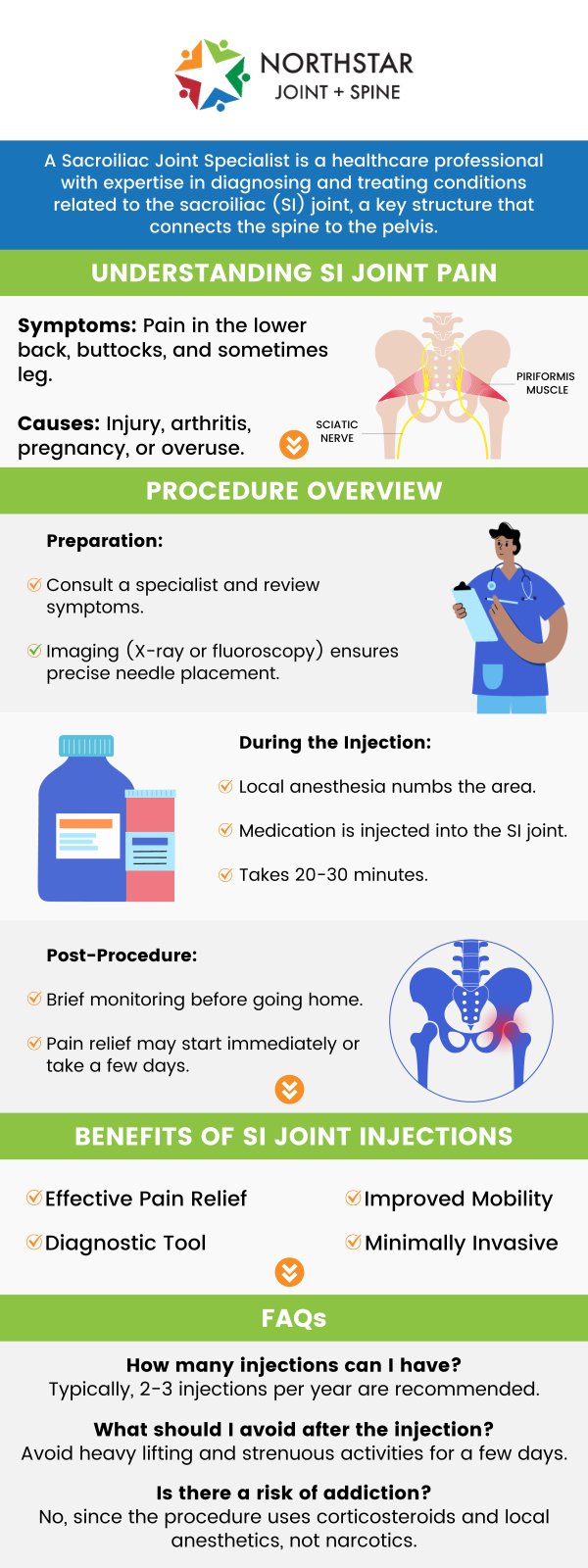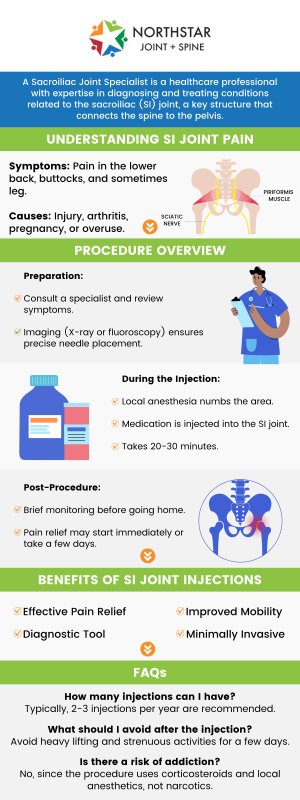Sacroiliitis: Causes, Symptoms, and Treatment Q&A
Sacroiliitis is the inflammation of the sacroiliac joints, which connect the spine to the pelvis. It can cause lower back pain, stiffness, and discomfort in the hips or buttocks. The condition is often linked to arthritis or infections and can significantly affect mobility. At Northstar Joint and Spine, Dr. Robert J. Nocerini offers comprehensive care to diagnose and treat sacroiliitis, helping you find relief and improve mobility. For more information, contact us today or schedule an appointment. We are conveniently located at 7704 San Jacinto Pl Suite #200 Plano, TX 75024.


Table of Contents:
What causes sacroiliitis?
What are the symptoms of sacroiliitis?
What aggravates sacroiliitis?
What happens if sacroiliitis is left untreated?
Sacroiliitis is often caused by inflammation within the sacroiliac joints, which link the lower spine to the pelvis. While the cause varies from person to person, common triggers often include repetitive strain or the gradual wear that builds up from long-term mechanical stress. Athletes, manual laborers, or those with physically demanding routines may begin to notice discomfort after prolonged periods of joint overuse. In other cases, the inflammation can be related to broader inflammatory conditions where the immune system targets the joints.
Pregnancy can also influence the onset of the condition, since hormonal changes and body changes may stretch or loosen the ligaments around the pelvis. Infections less commonly can lead to sacroiliitis as well, particularly when bacteria travel to the joint space. Sometimes, the condition develops without a clear reason, which makes early evaluation essential when symptoms persist. The specialists at Northstar Joint and Spine work to identify not just the pain itself but the underlying source, which helps guide more targeted and effective care.
The most consistent symptom is pain that starts low in the back or buttocks and may extend into the hips or upper legs. For some individuals, this pain surfaces as an aching pain that worsens after standing for long periods, climbing stairs, or when seated for a long period. The stiffness is often most noticeable in the morning or after inactivity, and while it may ease with light movement, it tends to linger and return throughout the day if not properly managed. Alongside the pain, some patients describe a sense of instability in the pelvis or discomfort that seems to shift from one side to the other. In more inflamed cases, walking can also trigger sharp jolts along the sacroiliac joint, particularly if both joints are affected. Because sacroiliitis shares overlap with other low back conditions, diagnosis can sometimes take longer than expected. Specialists can identify these symptoms and how they evolve to help develop a tailored treatment plan.
Movements that place uneven or repetitive strain on the lower spine and pelvis are often what aggravate sacroiliitis the most. Prolonged sitting can compress the joints and cause discomfort to build up. Similarly, standing in one place for too long or twisting while bearing weight may inflame the joint further. These day-to-day actions, while routine, can become more taxing when inflammation is already present and the joint space is more sensitive than usual. High-impact activities such as running or lifting heavy objects without proper alignment also contribute to flare-ups. Sleeping on an unsupportive mattress or staying in one position for too long overnight can leave the joint feeling stiff and sore by morning. The team at Northstar Joint and Spine focuses on identifying these movement patterns and modifying them as needed to reduce aggravation while building strength around the joint for added support.
If sacroiliitis goes unaddressed, what is originally an intermittent discomfort can become a more serious cause of pain that impacts a patient’s ability to function in their daily lives. Chronic inflammation may lead to reduced flexibility, making it harder to bend, twist, or move freely without aggravating the area. Over time, compensatory patterns may develop, where other joints or muscles take on extra strain, which can lead to new areas of pain and imbalance throughout the lower body.
Especially when linked to inflammatory conditions, inflammation can cause long-term structural changes within the joint. This may include damage to cartilage or joint fusion, which limits mobility and creates a persistent dull ache or sharp pain with movement. Early intervention helps to prevent these longer-term outcomes by managing the inflammation before it disrupts function or impacts surrounding areas. The specialists at Northstar Joint and Spine work to avoid such progression by catching the condition early and guiding patients toward long-term relief.
Sacroiliitis treatment is available at Northstar Joint and Spine. For more information, contact us today or schedule an appointment. We are conveniently located at 7704 San Jacinto Pl Suite #200 Plano, TX 75024. We serve patients from Plano TX, Willow Bend TX, Frisco TX, Allen TX, Addison TX, North Dallas TX, and surrounding areas.

Additional Services You May Need
▸ Back Pain
▸ Chronic Pain
▸ Epidural Steroid Injections
▸ Spinal Cord Stimulation
▸ Viscosupplementation
▸ Genicular Nerve Blocks
▸ Facet Injections
▸ Joint Injections
▸ Sacroiliac Joint Injections
▸ Lumbar and Cervical
▸ Facet Medial Branch Blocks
▸ Diagnostic Nerve Blocks
▸ Medication Management
▸ Neck Pain Doctor
▸ Diabetic Peripheral Neuropathy
▸ Headaches
▸ Suboxone
▸ Botox for Migraines
▸ Peripheral Nerve Stimulation

Additional Services You May Need
▸ Back Pain
▸ Chronic Pain
▸ Epidural Steroid Injections
▸ Spinal Cord Stimulation
▸ Viscosupplementation
▸ Genicular Nerve Blocks
▸ Facet Injections
▸ Joint Injections
▸ Sacroiliac Joint Injections
▸ Lumbar and Cervical
▸ Facet Medial Branch Blocks
▸ Diagnostic Nerve Blocks
▸ Medication Management
▸ Neck Pain Doctor
▸ Diabetic Peripheral Neuropathy
▸ Headaches
▸ Suboxone
▸ Botox for Migraines
▸ Peripheral Nerve Stimulation






